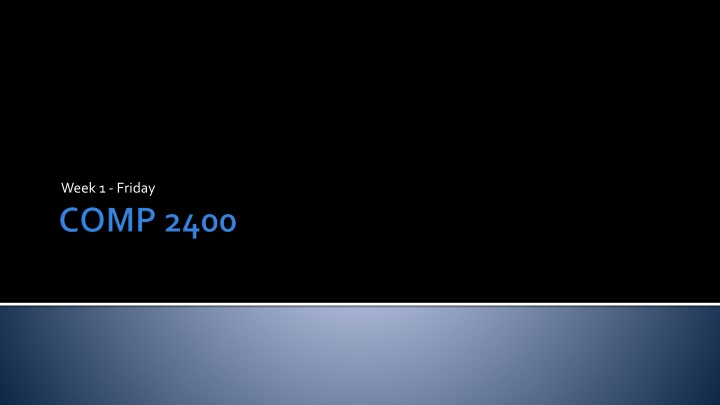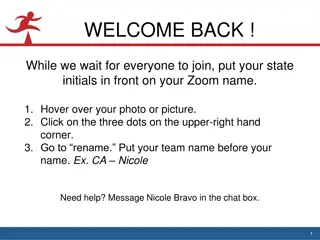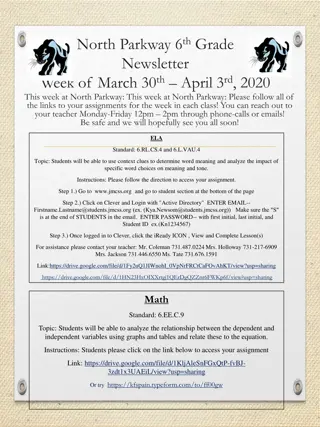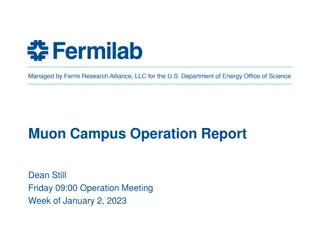
Basic Concepts of C Programming: Integer Literals, printf Function and More
Delve into essential concepts of C programming, including integer literals, the printf function with flags for printing integers in different formats, and insights on ANSI C philosophy. Explore topics such as history of Unix and Linux, C compilation model, and hexadecimal/octal literals.
Download Presentation

Please find below an Image/Link to download the presentation.
The content on the website is provided AS IS for your information and personal use only. It may not be sold, licensed, or shared on other websites without obtaining consent from the author. If you encounter any issues during the download, it is possible that the publisher has removed the file from their server.
You are allowed to download the files provided on this website for personal or commercial use, subject to the condition that they are used lawfully. All files are the property of their respective owners.
The content on the website is provided AS IS for your information and personal use only. It may not be sold, licensed, or shared on other websites without obtaining consent from the author.
E N D
Presentation Transcript
What did we talk about last time? More C basics C compilation model History of Unix and Linux
ANSI C retains the basic philosophy that programmers know what they are doing; it only requires that they state their intentions explicitly. Kernighan and Ritchie from The C Programming Language, 2ndEdition
By default, every integer is assumed to be a signed int If you want to mark a literal as long, put an L or an lat the end long value = 2L; Don't use l, it looks too much like 1 There's no way to mark a literal as a short If you want to mark it unsigned, you can use a Uor a u unsigned int x = 500u; Every value with a decimal point is assumed to be double If you want to mark it as a float, put an for an Fat the end float z = 1.0f;
You can also write a literal in hexadecimal or octal A hexadecimal literal begins with 0x int a = 0xDEADBEEF; Hexadecimal digits are 0 9and A F(upper or lower case) An octal literal begins with 0 int b = 0765; Octal digits are 0 7 Be careful not to prepend other numbers with 0, because they will be in octal! Remember, this changes only how you write the literal, not how it's stored in the computer Can't write binary literals
The printf() function provides flags for printing out integers in: %d Decimal %x Hexadecimal (%Xwill print A-Fin uppercase) %o Octal printf("%d", 1050); // Prints 1050 printf("%x", 1050); // Prints 41a printf("%X", 1050); // Prints 41A printf("%o", 1050); // Prints 2032
Our normal number system is base 10 This means that our digits are: 0, 1, 2, 3, 4, 5, 6, 7, 8, and 9 Base 10 means that you need 2 digits to represent ten, namely 1 and 0 Each place in the number as you move left corresponds to an increase by a factor of 10
Ten thousands Hundreds 3,482,931 Millions Ones Hundred thousands Tens Thousands
The binary number system is base 2 This means that its digits are: 0 and 1 Base 2 means that you need 2 digits to represent two, namely 1 and 0 Each place in the number as you move left corresponds to an increase by a factor of 2 instead of 10
Sixty fours 256's Sixteens Fours 11111101000 1024's Ones 512's Twos 128's Eights Thirty twos
This system works fine for unsigned integer values However many bits you've got, take the pattern of 1's and 0's and convert to decimal What about signed integers that are negative? Most modern hardware (and consequently C and Java) use two's complement representation
Two's complement only makes sense for a representation with a fixed number of bits But we can use it for any fixed number If the most significant bit (MSB) is a 1, the number is negative Otherwise, it's positive Unfortunately, it's not as simple as flipping the MSB to change signs
Let's say you have a positive number n and want the representation of n in two's complement with k bits 1. Figure out the pattern of k 0's and 1's for n 2. Flip every single bit in that pattern (changing all 0's to 1's and all 1's to 0's) This is called one's complement 3. Then, add 1 to the final representation as if it were positive, carrying the value if needed
For simplicity, let's use 4-bit, two's complement Find -6 1. 6 is 0110 2. Flipped is 1001 3. Adding 1 gives 1010
Let's say you have a k bits representation of a negative number and want to know what it is 1. Subtract 1 from the representation, borrowing if needed 2. Flip every single bit in that pattern (changing all 0's to 1's and all 1's to 0's) 3. Determine the final integer value
For simplicity, let's use 4-bit, two's complement Given 1110 1. Subtracting 1 1101 2. Flipped is 0010 3. Which is 2, meaning that the value is -2
Binary Decimal 0000 0001 0010 0011 0100 0101 0110 0111 Binary Decimal 1000 1001 1010 1011 1100 1101 1110 1111 0 1 2 3 4 5 6 7 -8 -7 -6 -5 -4 -3 -2 -1
Using the flipping system makes it so that adding negative and positive numbers can be done without any conversion Example 5 + -3 = 0101 + 1101 = 0010 = 2 Overflow doesn't matter Two's complement (adding the 1 to the representation) is needed for this to work It preserves parity for negative numbers It keeps us with a single representation for zero We end up with one extra negative number than positive number
Okay, how do we represent floating point numbers? A completely different system! IEEE-754 standard One bit is the sign bit Then some bits are for the exponent (8 bits for float, 11 bits for double) Then some bits are for the mantissa (23 bits for float, 52 bits for double)
They want floating point values to be unique So, the mantissa leaves off the first 1 To allow for positive and negative exponents, you subtract 127 (for float, or 1023 for double) from the written exponent The final number is: (-1)sign bit 2(exponent 127) 1.mantissa
How would you represent zero? If all the bits are zero, the number is 0.0 There are other special cases If every bit of the exponent is set (but all of the mantissa is zeroes), the value is positive or negative infinity If every bit of the exponent is set (and some of the mantissa bits are set), the value is positive or negative NaN (not a number) Number Representation 0.0 0x00000000 1.0 0x3F800000 0.5 0x3F000000 3.0 0x40400000 +Infinity 0x7F800000 -Infinity 0xFF800000 0x7FC00000 and others +NaN
For both integers and floating-point values, the most significant bit determines the sign But is that bit on the rightmost side or the leftmost side? What does left or right even mean inside a computer? The property is the endianness of a computer Some computers store the most significant bit first in the representation of a number These are called big-endian machines Others store the least significant bit first These are called little-endian machines
Usually, it doesn't! It's all internally consistent C uses the appropriate endianness of the machine With pointers, you can look at each byte inside of an int (or other type) in order When doing that, endianness affects the byte ordering The term is also applied to things outside of memory addresses Mixed-endian is rare for memory, but possible in other cases: http://faculty.otterbein.edu/ wittman1/comp2400/ More specific More specific
Function Result Function Result cos(double theta) exp(double x) Cosine of theta ex sin(double theta) log(double x) Sine of theta Natural logarithm of x tan(double theta) log10(double x) Tangent of theta Common logarithm of x pow(double base, double exponent) Raise base to power exponent acos(double x) Arc cosineof x asin(double x) sqrt(double x) Arc sineof x Square root of x atan(double x) ceil(double x) Arc tangent of x Round up value of x atan2(double y, double x) floor(double x) Arc tangent of y/x Round down value of x fmod(double value, double divisor) Remainder of dividing value by divisor fabs(double x) Absolute value of x
You must #include <math.h> to use math functions #include <math.h> #include <stdio.h> int main() { } double a = 3.0; double b = 4.0; double c = sqrt(a*a + b*b); printf("Hypotenuse: %f\n", c); return 0;
Just using #include gives the headers for math functions, not the actual code You must link the math library with flag lm > gcc hypotenuse.c -o hypotenuse -lm Now, how are you supposed to know that? > man 3 sqrt
Man (manual) pages give you more information about commands and functions, in 8 areas: 1. General commands 2. System calls 3. Library functions (C library, especially) 4. Special files and devices 5. File formats 6. Miscellaneous stuff 7. System administration Try by typing man topic for something you're interested in If it lists topics in different sections, specify the section > man 3 sqrt For more information: > man man
Preprocessor directives Single character I/O
Keep reading K&R Chapter 1 Keep working on Project 1 No class Monday!






















